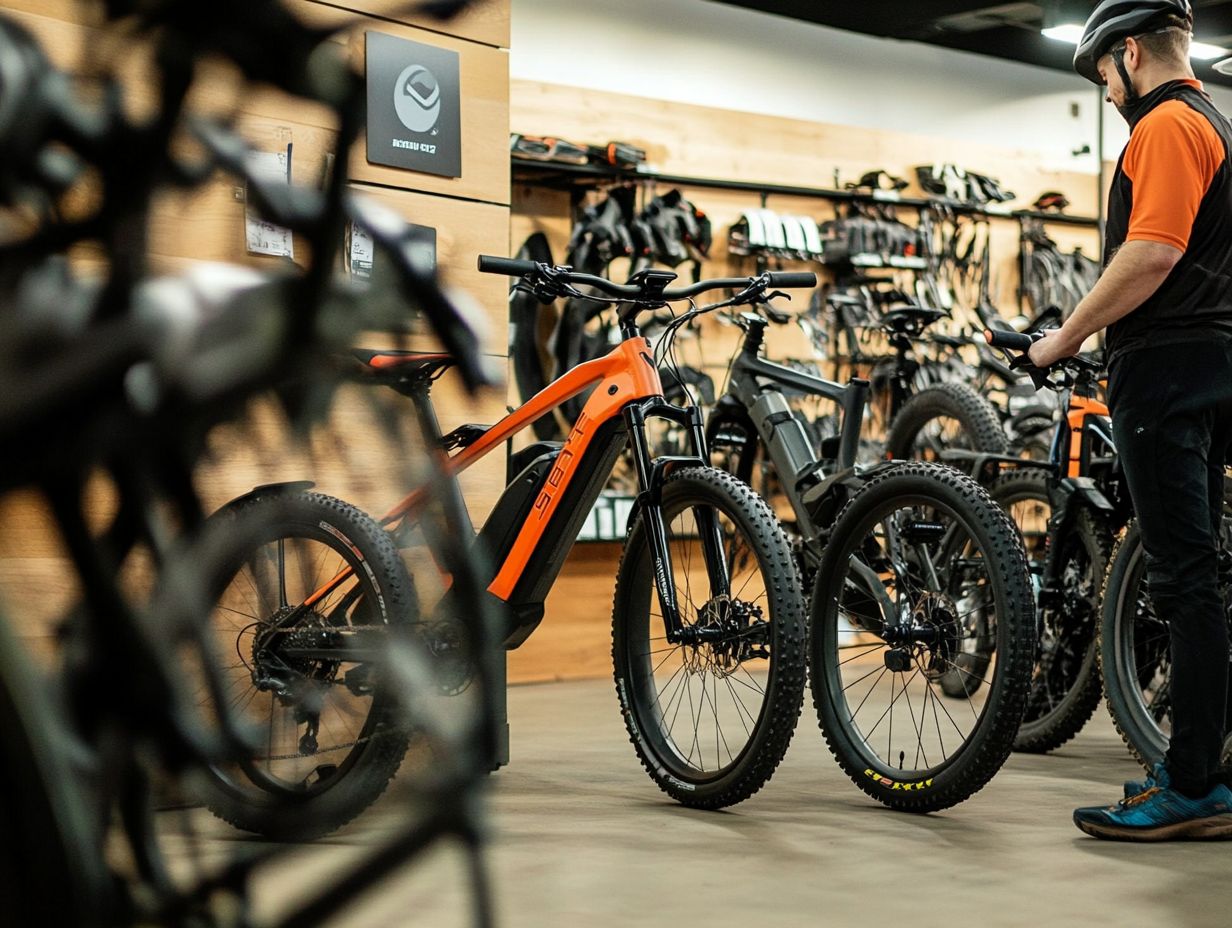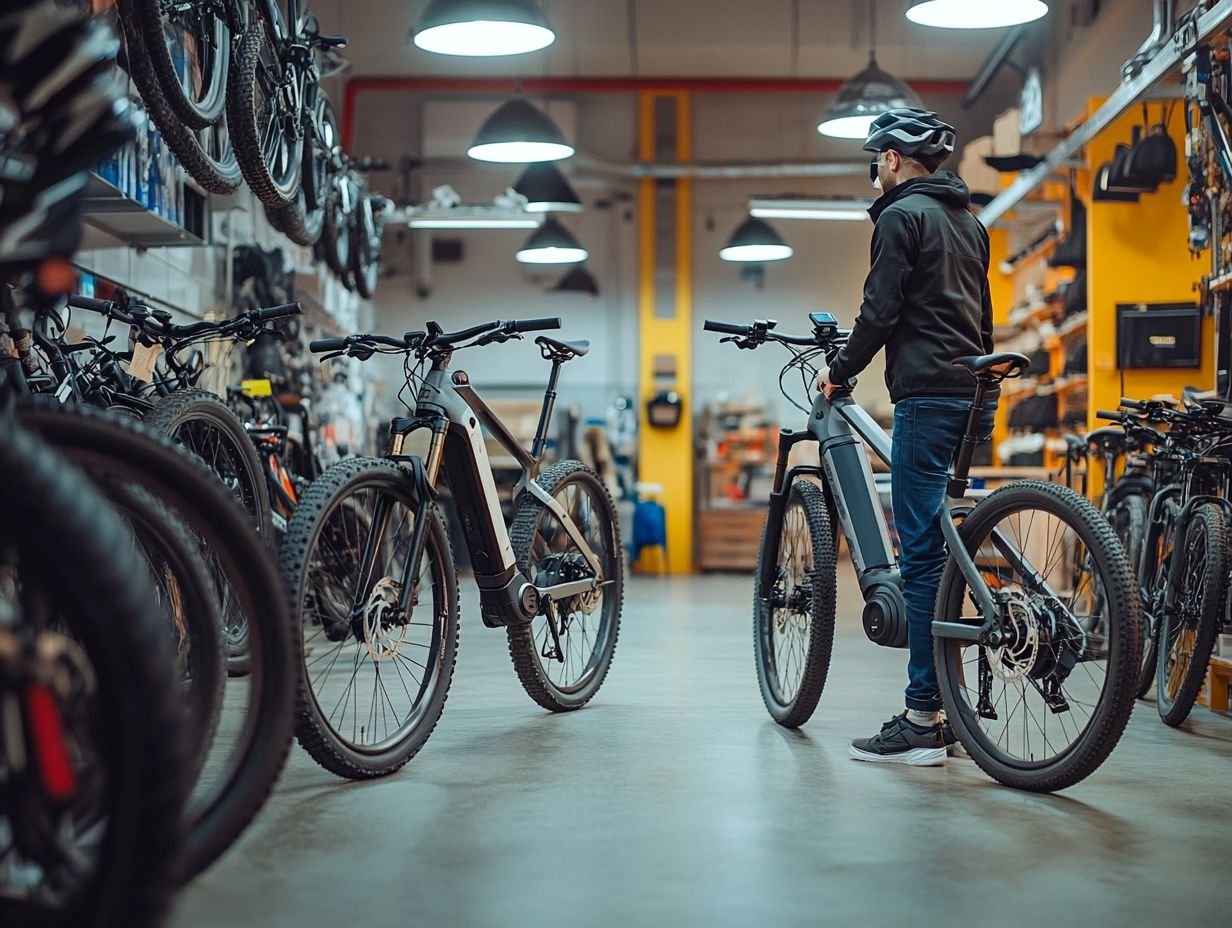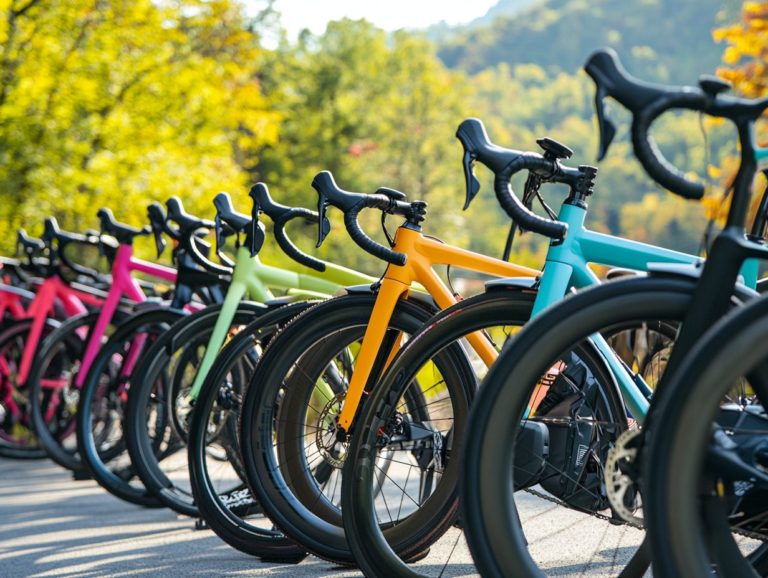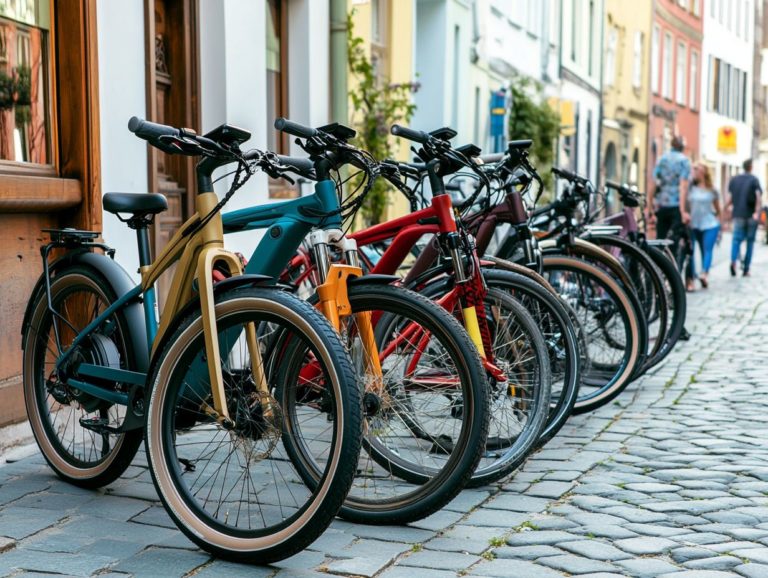Choosing the Right Electric Bicycle for Your Needs
Electric bicycles are the perfect blend of fun, convenience, and sustainability. With so many options, choosing the right one can feel like a daunting task.
This article will guide you through the essentials of electric bicycles, highlighting key factors such as price, power, and intended use. You’ll explore various types of e-bikes tailored to help you discover the style that best complements your lifestyle.
Are you ready to embark on this ride? Let s dive in!
Contents
- Key Takeaways:
- Understanding Electric Bicycles
- Factors to Consider When Choosing an Electric Bicycle
- Types of Electric Bicycles
- Tips for Choosing the Right Electric Bicycle
- Frequently Asked Questions
- What factors should I consider when choosing the right electric bicycle for my needs?
- How do I determine the appropriate size for an electric bicycle?
- What type of battery should I look for in an electric bicycle?
- Do I need a license to ride an electric bicycle?
- What are the different types of electric bicycles available?
- Can I convert a regular bicycle into an electric bicycle?
Key Takeaways:

- Consider your budget and intended use when choosing an electric bicycle. Price, power, battery life, size, and weight are important factors to consider.
- There are various types of electric bicycles, such as city/commuter bikes, mountain bikes, folding bikes, and hybrid bikes. Each type has unique features and is suited for different purposes.
- Test riding and researching are crucial steps in choosing the right electric bicycle. Testing the bike lets you experience its performance and gather information to make an informed decision.
Understanding Electric Bicycles
Understanding electric bicycles, commonly known as e-bikes, requires an awareness of their increasing popularity in urban commuting and recreational pursuits. You’ll encounter various classes and types, including Class 1, Class 2, and Class 3 models, each designed for distinct riding experiences.
These bicycles are equipped with advanced features like pedal assist and throttle assist. Pedal assist means the motor helps you pedal, while throttle assist lets you control the bike s speed without pedaling. Whether you’re considering e-bikes for daily commuting, leisurely rides, or off-road adventures, familiarizing yourself with their types and functionalities is crucial for both efficiency and enjoyment on two wheels.
Factors to Consider When Choosing an Electric Bicycle
When selecting an electric bicycle, several key factors significantly influence your decision-making process. Considerations such as price and budget constraints, power levels, battery life expectations, and the overall weight of the e-bike are essential.
Understanding your intended use whether it s urban commuting, off-road adventures, or leisurely rides will guide you toward the option that best aligns with your lifestyle.
By thoughtfully evaluating these components, you can effectively navigate the e-bike landscape and discover a model that meets your needs without compromising on quality or performance.
Price and Budget
When considering the purchase of an e-bike, price and budget will undeniably be at the forefront of your decision-making process. These factors will guide you toward either entry-level options or high-end models. It s essential to understand the cost range associated with various e-bike styles, including key features like motor placement and battery quality. This knowledge will enable you to allocate your budget effectively for the performance you desire.
Typically, entry-level e-bikes fall within the range of $500 to $1,500, offering basic functionalities that are perfect for casual riders. On the other hand, mid-range options often hover between $1,500 and $3,000, presenting enhanced features such as better battery life and lightweight frames. If you’re leaning toward high-end models, which can exceed $3,000, you ll find they justify their price tags with advanced technologies like integrated GPS, high-performance motors, and solid warranty packages.
Consider not only the initial costs but also the long-term value associated with maintenance and repairs. A comprehensive warranty can significantly mitigate future expenses, making what may seem like a higher-priced e-bike a smarter investment over time.
Power and Battery Life
Power and battery life are essential aspects of any e-bike, shaping not only how efficiently you ride but also how far you can go on a single charge. Most e-bikes are equipped with lithium-ion batteries, which directly influence their battery range and performance. The choice between hub motors and mid-drive motors plays a significant role in determining how power is delivered and how enjoyable your ride will be.
Hub motors are located in the wheel, while mid-drive motors are placed near the pedals, giving you different riding experiences. Hub motors offer a straightforward, reliable option perfect for urban commuting, while mid-drive systems shine in off-road conditions and steep climbs, thanks to their ability to leverage the bike’s gears. The inclusion of sensors that measure how hard you are pedaling and how fast enhances the experience, adjusting power output dynamically.
For instance, a bike with a 500Wh battery can provide a range of up to 50 miles, allowing you to confidently navigate various terrains. Imagine zooming through the hills with a reliable battery that takes you far without recharging! If you re looking for even greater capabilities, higher-capacity batteries, such as those rated at 750Wh, can extend this range further, making it crucial to choose wisely to optimize your e-bike’s performance.
Size and Weight

The size and weight of an e-bike are crucial factors that directly impact your riding comfort and the bike s performance. Opting for a lighter e-bike, often crafted from premium frame materials, can significantly enhance your maneuverability and ease of use, especially in urban environments and during your daily commutes.
The weight of the e-bike plays a pivotal role in its handling, particularly as you navigate tight corners or unpredictable terrain. A heavier bike may hinder your agility, making quick maneuvers feel awkward and cumbersome. Battery efficiency is another essential aspect affected by the overall weight; lighter e-bikes typically offer better range, allowing you to embark on longer journeys without the constant need to recharge.
When it comes to storage, lighter models shine by being easier to lift and fit into compact spaces, whether it’s a bike rack or your apartment. If you’re in the market for the perfect size, consider your height and body type; a well-fitted e-bike not only amplifies your comfort but also elevates your riding experience. For more insights, check out comparing different electric bicycle designs.
Intended Use
Understanding the intended use of an e-bike is essential when selecting the perfect model. Different types cater to specific riding experiences, whether you re urban commuting, off-road biking, or transporting cargo. Consider models like fat-tire bikes and hybrid e-bikes, which offer unique capabilities to navigate diverse terrains and meet various rider needs.
If you’re a commuter, you might lean towards lightweight designs with streamlined frames and impressive battery ranges for your daily rides. If rugged terrain is your playground, consider exploring choosing the right electric bicycle type for you—powerful motors and robust tires are likely at the top of your list to conquer uneven paths.
Cargo e-bikes are equipped with sturdy racks and enhanced stability, making them ideal for transporting heavy loads through bustling urban environments. Each type is a carefully crafted blend of components optimized for performance based on your intended use. You ll love the smooth ride, whether you re zipping through city streets or tackling rugged trails!
Types of Electric Bicycles
The world of electric bicycles presents a rich tapestry of e-bike types, each tailored to meet unique riding needs and preferences. You ll find commuter bikes designed for your daily journeys, cargo bikes built to transport your loads with ease, fat-tire bikes that tackle off-road adventures, and folding bikes that emphasize convenience and portability.
Hybrid e-bikes combine elements from various styles, offering you a versatile option for both everyday errands and leisurely outings. Think about what type of riding you’ll be doing. Your ideal e-bike is just around the corner!
City/Commuter Bikes
City or commuter bikes are designed to elevate your urban riding experience. They blend comfort with performance.
These e-bikes have lightweight frames and strong battery ranges. Glide through traffic and enjoy swift commutes.
Many commuter bikes come with built-in racks or pannier mounts. Easily carry groceries or work gear.
Their ergonomic designs include fenders for all-weather riding, lights for night visibility, and adjustable handlebars to suit your style.
Choosing these bikes over driving or public transport reduces your carbon footprint. Plus, you’ll enjoy the exercise and freedom of navigating busy streets!
Mountain Bikes
Mountain bikes are crafted specifically for off-road biking enthusiasts. They showcase robust frames, advanced suspension systems, and powerful motors that deliver exceptional performance on rugged terrains.
These e-bikes provide stability and control, perfect for tackling challenging trails and paths.
You ll find them equipped with wider tires that enhance traction and grip. Navigate rocky landscapes with ease!
The quality of suspension can vary. Some models feature adjustable settings that absorb shocks and bumps for a smoother ride.
When selecting an ideal off-road e-bike, consider gear configurations for various inclines and declines. This ensures versatility to conquer steep climbs effortlessly.
Features like battery capacity, weight distribution, and frame material significantly impact your experience in rugged outdoor settings.
Folding Bikes

Folding bikes are an excellent choice for urban riding, thanks to their compact design. They allow for effortless storage and transportation.
You ll quickly love how easily these bikes can be taken into cafes, offices, or even apartments without hogging too much room.
Their lightweight design turns conveniences into essential features, enhancing your overall ride experience.
Of course, don t overlook the trade-offs, like smaller wheel sizes, which can impact stability on uneven roads. However, the benefits cater to those seeking a practical and stylish solution for daily travel.
Hybrid Bikes
Hybrid e-bikes seamlessly merge the finest qualities of road and mountain bikes. They provide versatility to transition effortlessly between urban commuting and leisurely rides.
These e-bikes boast a balanced design that adapts to various terrains, ensuring a comfortable experience no matter where your journey takes you.
The defining features include wider tires for enhanced grip and stability. They are equally at home on paved roads and unpaved trails.
With a lightweight yet robust frame, these bikes offer durability while maintaining an agile feel, ideal for navigating bustling city streets or serene country pathways.
Performance features like adjustable suspension systems and responsive braking will elevate your ride. Owning a hybrid e-bike promotes an active lifestyle and encourages exploration!
Transform your daily commutes into enjoyable and invigorating adventures.
Tips for Choosing the Right Electric Bicycle
Selecting the right electric bicycle requires a thoughtful approach. Employing effective buying tips is crucial. Be sure to test ride different models and do thorough research to understand the performance features that cater to your specific needs.
This helps you choose an e-bike that matches your riding style and preferences, ultimately enhancing your overall experience.
Test Riding and Researching
Test riding and researching are essential steps in your e-bike buying journey. They allow you to experience firsthand the ride quality and comfort that various models offer.
While taking those test rides, diving into online research can enhance your experience. It provides insights into specifications and customer reviews.
During a test ride, focus on key aspects like handling, acceleration, and brake responsiveness. Pay attention to how the weight distributes; it can significantly affect your comfort, especially on longer rides.
Familiarizing yourself with different e-bike types like commuter versus mountain models will help you match your needs with the ideal specifications.
Don’t overlook the performance features. Battery life, motor power, and assist levels are critical factors that guide you toward informed choices, elevating your overall riding experience. Additionally, consider the differences between types of bikes, such as city vs. mountain electric bicycles. By engaging in this thorough evaluation process, you’ll be well-equipped to select an e-bike model that aligns perfectly with your lifestyle.
Frequently Asked Questions
What factors should I consider when choosing the right electric bicycle for my needs?

When choosing an electric bicycle, consider the type of terrain you’ll be riding on, your budget, the distance you’ll be traveling, your level of physical fitness, and the features you want in the bike.
How do I determine the appropriate size for an electric bicycle?
The size of an electric bicycle is determined by the frame size, which should be chosen based on your height and inseam measurements. Most manufacturers provide size charts to help you find the right fit.
What type of battery should I look for in an electric bicycle?
The type of battery will depend on your needs and preferences. Lithium-ion batteries are the most common and offer a good balance of weight, range, and cost. However, if you need a longer range, a larger battery capacity, such as a lithium-ion phosphate battery, may be a better option.
Do I need a license to ride an electric bicycle?
In most countries, electric bicycles that have a maximum speed of 20 mph and a motor with a power output of 750 watts or less do not require a license. However, it s always best to check your local laws and regulations to be sure.
What are the different types of electric bicycles available?
There are several types of electric bicycles available, including city/commuter bikes, mountain bikes, folding bikes, and cargo bikes. Each type is designed for a specific purpose and offers different features, so it’s important to choose one that suits your needs.
Can I convert a regular bicycle into an electric bicycle?
Yes, it is possible to convert a regular bicycle into an electric one by installing a conversion kit. However, this may void the warranty on your bike and can be more expensive than buying a pre-made electric bicycle.
Start your journey to find the perfect electric bicycle today!






